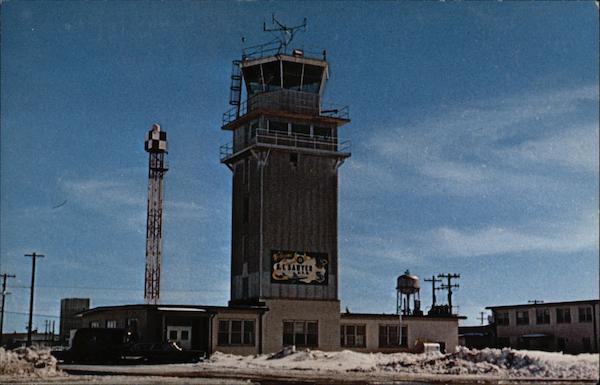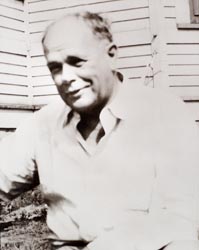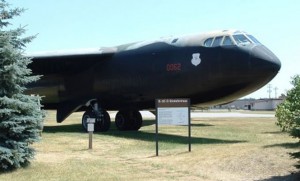
Introduction
Driving through the heart of the Upper Peninsula of Michigan, just south of Marquette, the winding two lane road leads to gated entrance with a sign that reads “Welcome to the K.I. Sawyer A.F.B.” At one point in time, the entrance booth would have contained an attendant and the road would lead to the bustling compound that was once a fully operational United States Air Base, formally called the K.I. Sawyer Air Force Base. Surrounded by the Escanaba River State Forest, the vast compound was once a contributor in United States’ success in the Cold War preventing and monitoring attempts of Soviet invasion. This led to the men and women who were stationed there often being referred to as the “Guardians of the North”.
Origins
The origin of the K.I. Sawyer A.F.B goes back to the mid-1930s when it was originally established as a civilian airport. Kenneth Ingalls Sawyer, a civil engineer and Marquette Road Commissioner, saw that there were many economic advantages for a new airport that would aid in the development of the Marquette area. These included increased tourist travel to the area, and by 1937, air transport of iron ore to keep up with the ever-increasing demand during World War II (Find a Grave). A county airport was built in southwest Marquette. However, the area experienced even more growth than anticipated. By 1941, Sawyer proposed a plan for new airport. The airport was approved and built (Grabowski).
From Airport to Air Base
Sawyer never lived long enough to see the new airport built and died on January 12, 1944 (Find a Grave). Upon completion, the airport was the named the K.I. Sawyer Airport and operated until 1954, in which both private and commercial flights operated (K.I. Sawyer Heritage Museum). With the growing concerns arising from the Cold War, the government made the decision to build new bases across the country. As tensions between the United States and the Soviet Union grew, the United States government became increasingly concerned about the relations between the two nations and precautionary measures were taken against possible Soviet attacks on the United States. Recognizing that the military needed a better “view” of the north, K.I. Sawyer was chosen along with bases in Grand Forks and Minot, North Dakota and Glasgow, Montana. These locations provided excellent reception capability for radar, making them logistically beneficial for the Air Force. This is due to the position along the Canadian border. These bases would be the first locations to recognize and notify the government of potential attacks from the north (Shaw, 71).
In addition to being a logistical military asset, the area surrounding the base provided an enjoyable experience for the employed military personnel, most particularly with the access to outdoor activities, such as hiking, fishing, hunting, boating, and skiing, Though was sometimes referred to as “K.I. Siberia”, it was reported that many of the personnel enjoyed the area (K.I. Sawyer Heritage Museum).
In January 24, 1955, the U.S. Government signed a 99-year lease establishing the airport as the K.I. Sawyer Air Force Base. The original proposal was that the base be used as a civilian airport as well as military base. This agreement lead to the installment of a $12 million jet base and additionally limited the amount of civilian aircraft landings to 300 per month (Grabowski). Construction began immediately and employed approximately 850 people. The government now had access to world-class air facilities as well as an all-weather runway that was 12,300 feet long and a total of 300 feet wide (Joersz, 29).
The agreement only lasted a short while, however, and as negotiations between the United States government and Marquette County began, the base was soon established and transferred to complete Air Force control. On January 24, 1956 Lt.Col. Robert L. Brocklehurst was named the first commander of K.I. Sawyer Air Force Base (Gwinn Chamber of Commerce). The base was then fully activated by military personnel on April 8, 1956. The last non-military functions of the base were discontinued in 1957 (Joersz, 9).
Operations
The most critical functions the base provided was the use of early warning network radar lines and Semi-Automatic Ground Environment (SAGE) facilities. Being so far north, the technology was used to deter any potential threats imposed by the Soviet Union if any attacks were to come from over the Canadian border. The United States government expressed growing concern about the possibility of the Soviet Union using bombers or Intercontinental Ballistic Missiles (ICBMs) as a form of attack against the country (Shaw, 72).
The SAGE systems revolutionized air defense for the United States. It was the first time that an automated nationwide computer based air defense system was used. The automatic data-processing capability took the place of manual Ground Control Interception (GCI) systems in “observing, plotting, transmitting information and assigning targets for air defense weapons”. SAGE facilities, such as K.I. Sawyer, processed air surveillance information collected from surrounding radar stations. This information contained whereabouts and paths of things like commercial aircraft, military aircraft, and most importantly, enemy missiles. The data was then sent directly to Air Defense Command units. This meant that the radar data could be analyzed in real time, and threats could be recognized and dealt with immediately. Another advancement was the display scope. This scope provided a screen that could analyze the data and render it as graphics. This was the first time airmen could have the attack visualized for them on a screen. They could see the battle happening, as well as rewind the battle to “see how things got that way”, utilizing one of the first instances of computer memory. This, at the time, was revolutionary. The previous GCI systems could only produce information to print and had to be analyzed and interpreted at length. The new SAGE systems could allow the “split second presentation, as well as split second calculation” (IBM). As the number of ICBMs on alert started to exceed the number of bombers on ground alert, northern bases became increasingly important to the Air Force (FAS).
When the base was activated, it was immediately put under the jurisdiction of the Air Defense Command (ADC) and in 1964 the Strategic Air Command (SAC). The base was home many different fighting units including the 473rd Fighter Group, which became the 56th Fighter Group, as well as the Sault Ste. Marie Air Defense Sector and the 4042nd Strategic Wing. The 4042nd Strategic wing was discontinued and the 410th Bombardment Wing was activated in February 1963. The Wing then began conducting flying missions with aircraft such as the B-52H Stratofortress, a new fighter jet, and the KC- 135 Stratotanker, an aerial refueling plane, both developed by Boeing. 1963 also saw the end of the 56th Fighter Group on April 30, 1971. The base was also home to other divisions such as the 87th Fighter Interceptor Squadron, which ran until October 1, 1985, the 410th Combat Support Group, the 2001st Communications Squadron, as well as serving as the 71st Flying Training Wing. The SAC was disbanded in June of 1992 and the base came under control of the Air Combat Command (ACC) (Joersz, 9). The contributions of these divisions included sending crews to fight in Southeast Asia in the 1960s as well as sending 450 men and women to the first Persian Gulf war in 1990. They were deployed in support of Operation Desert Shield.
Closure and Economic Impact
The KI Sawyer Air Force Base had a history with the Defense Base Closure and Realignment Commission (BRAC), even before its official closure in September 1965. The base was declared to be on the closure list several different times. The base was considered for closing among others but continually had other closed bases’ resources transferred there instead. This was a relief to the base and the surrounding community, as the base provided crucial economic support to the surrounding area. After the Kincheloe base in western U.P. closed down, growing concerns regarding the future of the base rose. However, the base was saved was in 1975 when the Navy insisted on keeping the base open as a potential site to implement the highly criticized Seafarer Program (Mining Journal). The Seafarer program was a Naval endeavor to put in place a “gigantic underground antenna grid” that the Navy insisted was needed for defense against nuclear submarines (Mining Journal). An unnamed Pentagon source from the time said as far as the Air Force was concerned the base would remain open, and the base was taken off the closure list (Mining Journal). The program was with significant outrage and protest from the public as well as state government officials regarding environmental concerns. People against the idea of nuclear weapons were also against the program. In the winter of 1978, a march was held at the base against the program held by the Great Lakes Life Community, ending in the crowd being drenched by a fire hose. The group was against any connection with nuclear weapons, as they were seen as a threat to all life (Mining Journal). The Navy never succeeded with implementing the system and the endeavor eventually failed altogether. Though the program was never implemented, it allowed the continuation of operations at the base. Finally, after continuing to bounce on and off the closure list, 1993 marked the official closing of the base and in September 1995, all military activity ceased and the K.I. Sawyer Air Force Base officially closed (Shaw, 172).
The closing of the base had a profound and devastating effect on the Marquette area economy. The base had once employed around 880 civilians as well as the 3,200 active military personnel (Joersz, 35). These jobs in themselves created almost 2,000 other secondary jobs. All people employed had access to a job, income, medical care, and housing. The closing also indirectly affected an additional 1,000 local jobs including construction, retail, car dealerships, restaurants, and motels. These establishments quickly experienced drastic drops in income. The closing had a profound effect on places such as Northern Michigan University and Gwinn are public schools as well. The military was funding $500,000 for up to 500 military personnel annually to pursue degrees. The added children enrolled in the public schools allowed for more government funding and better quality schools. This loss of tuition was coupled with the 157 million annual Air Force spending that expanded over a 50 mile radius. These losses left a hole in the area’s economy. The town of Sawyer went into a steep economic decline. Before its closure the county faced the prospect of losing at least 20% of its local economy, with no immediate means of filling the hole. In the words of Herb Parsons, “When you have a facility the size and scope of K.I. Sawyer, you’re talking about a Fortune 500 company” (Rohan).
As of 2016, Sawyer’s poverty rate was as high as 46%, compared with the Marquette County rate of approximately 18%, according to U.S. census data from 2014. Unemployment in the area has reached as high as 24%. The area has also become a reputable “drug den” after dealers took advantage of the emptying compound upon its closure in the 1990s. Housing costs dropped significantly, but this was not enough to lure people into the area (Dawsey).
Future Plans
The abandoned base is on a 5,200-acre plot and contains buildings used for housing, medical facilities, air facilities, as well as many other structures (Telender). Due to vandalism and general run-down of the buildings, the base was once considered a public safety hazard as well as a general “unsightly place” (Dawsey). After the base’s closing there were endeavors being made to convert the facilities into educational or an Olympic training location. Though these initial attempt at achieving economic stability were not successful, in 1999, part of the base was used as the new Sawyer International Airport. A new terminal building was completed by September 25, 1999 and and has one of the longest runways in North America. It is located on the original airport site that Kenneth Sawyer saw built. The new airport positioned for serving the central Upper Peninsula. Due to the military airports program, Sawyer International Airport received special funding and is ready for the next century’s air fleets that include jumbo jets due to the length of the runway. Telkite Technology Park now exists at the former base. The park is known for high tech, aviation, and commercial development and is home to companies such as Telkite Enterprises, LLC, AMR Eagle, Superior Extrusion, and more. American Airlines and Delta fly out of Sawyer and serviced as many as 100,000 passengers in 2011 (Community Relations Plan, Appendix H, 2). Other progress is being made and there are many establishments beginning to operate in the area, including gas stations, a dentist clinic, and a community center. Many companies are expressing interest in expanding businesses to the area. These upgrades allow the locals remain hopeful, and remain certain that Sawyer is not a finished project (Dawsey).




(from kishamuseum.org)
Primary Sources
- Rohan, Barry. “Closing of Base In Upper Peninsula Casts Cloud Over Employment Gains.” Chicago Tribune, 15 Aug. 1993.
- “Base in No Danger of Closing.” The Mining Journal, 12 Mar. 1976.
- Joersz, Eldon W. Ecomomic Impact Statement. Ecomomic Impact Statement.
- “Anti-Seafarer Marchers Halted at Sawyer Base.” The Mining Journal, 30 Jan. 1978.
- IBM. “”On Guard: The Story of SAGE”, 1956. Youtube.com, 24 May 2013.
Secondary Sources
- Former K.I. Sawyer Air Force Base Community Relations Plan. Appendix H, United States Air Force, 2011.
- Telender, Luke . “Community Progress Blog.” How Marquette County Land Bank took on property at an abandoned air force base | Community Progress Blog | Center for Community Progress, 14 Dec. 2014
- “Kenneth I. Sawyer.” Kenneth I. Sawyer (1884 – 1944) – Find A Grave Memorial, Find a Grave, 1 May 2000.
- Grabowski, Michael. “Sawyer Offered More than Name to Community.” Marquette Monthly, June 2005.
- Grabowski, Michael. “A Closer Look: K.I. Sawyer Air Force Base.” Marquette Monthly, June 2005.
- Shaw, Frederick J, editor. “Locating Air Force Base Sites History’s Legacy.” Air Force History and Museums Program, 2014
- “K.I. Sawyer History.” Official Website | K.I. Sawyer Heritage Air Museum.
- “Semi-Automatic Ground Environment (SAGE).” Semi-Automatic Ground Environment (SAGE) – United States Nuclear Forces, 29 June 1999
- Chastity Pratt Dawsey | Bridge Magazine. “Poverty in the UP: Down and out in purest Michigan.” MLive.com, MLive.com, 21 June 2016.
- “This History of Sawyer.” This History of Sawyer, Gwinn Chamber of Commerce.
For further reading
- “K. I. Sawyer Air Force Base.” Wikipedia, Wikimedia Foundation, 12 Nov. 2017.
